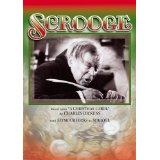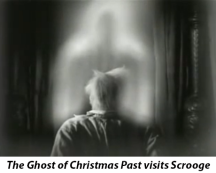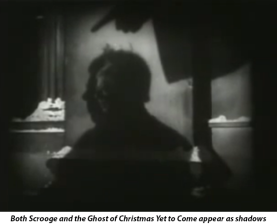 I began with the 1935 Seymour Hicks (Sir Edward Seymour Hicks) version. This is commonly known as the first sound movie version of A Christmas Carol (ACC) and has the title of Scrooge. I don’t have many memories of this version until the 1980’s when it began appearing on television a lot despite the bad prints being used. The first thing that is notable about this before getting to the film itself is Seymour Hicks’ familiarity with the character of Scrooge. Hicks first played Ebenezer Scrooge on stage in 1901 and played it for many years. He was 30 years old. (1901 is the same year the first silent film version was made!) The first time he played Scrooge on film was in the 1913 silent movie version of Scrooge (called Old Scrooge in the U.S.). By the time this first full-length sound version was made, Hicks was at least 64 years old and well seasoned with the character having 30 years experience with old Ebenezer. I’ve “graduated” from my ‘80’s public domain VHS (and early DVD) 60-minute version to a better full-length DVD at over 75 minutes.
I began with the 1935 Seymour Hicks (Sir Edward Seymour Hicks) version. This is commonly known as the first sound movie version of A Christmas Carol (ACC) and has the title of Scrooge. I don’t have many memories of this version until the 1980’s when it began appearing on television a lot despite the bad prints being used. The first thing that is notable about this before getting to the film itself is Seymour Hicks’ familiarity with the character of Scrooge. Hicks first played Ebenezer Scrooge on stage in 1901 and played it for many years. He was 30 years old. (1901 is the same year the first silent film version was made!) The first time he played Scrooge on film was in the 1913 silent movie version of Scrooge (called Old Scrooge in the U.S.). By the time this first full-length sound version was made, Hicks was at least 64 years old and well seasoned with the character having 30 years experience with old Ebenezer. I’ve “graduated” from my ‘80’s public domain VHS (and early DVD) 60-minute version to a better full-length DVD at over 75 minutes.
One of the things I like in this version is the atmosphere and its innovation of showing us the disparity of classes in early Victorian London. I used to imagine that, even though made in 1935, the non-Hollywood English filmmakers were probably closer to giving us a more accurate London of the period than any version following for the next 30 – 40 years. …at least, that was once my thinking.
I’ve known many folks’ opinion of Hicks as Scrooge run the gamut: he’s either a favorite or he’s bottom of the barrel. I’d put him in the upper middle. He has a good grasp of the Character and I believe he is Scrooge when I watch him. He is a fine actor. His background from such an old European school acting/theatrical tradition isn’t anything like some of the other actors in the film: the forced behavior and emotion, stylized oratories, rarely instinctive responses, which translates to contemporary tastes as “over the top.” The guiltiest culprit is Mary Glynne as Belle. Her acting feels like it belongs to an old 19th century American melodrama – slightly cringe worthy, slightly laughable. Donald Calthrop is one of the better Bob Cratchits. I think one of the reasons I like him is how closely he resembles the Cratchit of John Leech’s original illustration. The stylized acting surely owes some of its indulgence to director Henry Edwards. Edwards himself was also an old-school actor and directed many films as well. An interesting connection: Edwards was in the 1948 film version of Oliver Twist that starred Alec Guinness as Fagin. Alec Guinness also happened to play my favorite Marley in the 1970 musical version Scrooge (being saved for a later posting).
So let’s get to the elephant in the room: the well-known distinction this version has for its portrayal of the ghosts, or rather, lack thereof. All three ghosts have physical appearances even if subtle and not very commanding. It is actually Marley’s ghost that doesn’t appear on the screen. The only glimpse we ever get of Marley is when his face appears on the doorknocker. It seems many other viewers are often put off by the portrayal of Marley and the three ghosts. I get that. But I have a quirk where I always try to find a positive aspect of every version, though I’m not always successful with a few of them. My perception is that is seems fitting for this particular production, which often seems like a 1930’s art film performed by actors from a strong theatrical tradition. An invention of the film, when Marley enters Scrooge’s room he says, “Look well, Ebenezer Scrooge, for only you can see me.” We hear a ghost that we cannot see simply because we are not meant to. Conveying the shock of Marley is the job for the acting skills of Hicks. His facial expressions convey the horror while he makes us believe he is actually interacting with someone who doesn’t appear to be there.
 The Ghosts of Christmas Past and Future are as physically vague as the parts of linear time they represent. As Dickens states in his text, the past and future are “shadows,” therefore so are their representative spirits. The Past is a light shadow. The past, though gone and only transparently visible through memory, can shed light and offer clarity when braving to look at it honestly. There is a vague logic to the Ghost of the Past being a mostly opaque figure outlined by light. It is certainly not fully how Dickens described it, but there’s a sense to it. The future is a dark shadow. It has not yet happened. It is unknown so it remains in darkness and sheds no light. Dickens decribied it: It was shrouded in a deep black garment, which concealed its head, its face, its form, and left nothing of it visible save one outstretched hand. But for this it would have been difficult to detach its figure from the night, and separate it from the darkness by which it was surrounded. Here I can see the film’s concept of only the finger-pointing shadow for the Future ghost. Taking it further, as Ebenezer observes and moves about the future that are shadows, he does so as a shadow himself! The Ghost of Christmas Present is the only spirit representing a tangible or perceivable ti
The Ghosts of Christmas Past and Future are as physically vague as the parts of linear time they represent. As Dickens states in his text, the past and future are “shadows,” therefore so are their representative spirits. The Past is a light shadow. The past, though gone and only transparently visible through memory, can shed light and offer clarity when braving to look at it honestly. There is a vague logic to the Ghost of the Past being a mostly opaque figure outlined by light. It is certainly not fully how Dickens described it, but there’s a sense to it. The future is a dark shadow. It has not yet happened. It is unknown so it remains in darkness and sheds no light. Dickens decribied it: It was shrouded in a deep black garment, which concealed its head, its face, its form, and left nothing of it visible save one outstretched hand. But for this it would have been difficult to detach its figure from the night, and separate it from the darkness by which it was surrounded. Here I can see the film’s concept of only the finger-pointing shadow for the Future ghost. Taking it further, as Ebenezer observes and moves about the future that are shadows, he does so as a shadow himself! The Ghost of Christmas Present is the only spirit representing a tangible or perceivable ti me, therefore he is the only one in full form. One other note about the Ghost of Christmas Past: Dickens is ambiguous about the visual age of the Ghost of Christmas Past but doesn’t definitively state the gender (when he writes “him” it can be interpreted simply as proper English using the sex-neutral third-person singular noun. While the gender of the Ghost of Christmas Past is different amoung the various versions, here we get a slight mix. The figure of the ghost is portrayed by a woman (Marie Ney) while the voice is a man.
me, therefore he is the only one in full form. One other note about the Ghost of Christmas Past: Dickens is ambiguous about the visual age of the Ghost of Christmas Past but doesn’t definitively state the gender (when he writes “him” it can be interpreted simply as proper English using the sex-neutral third-person singular noun. While the gender of the Ghost of Christmas Past is different amoung the various versions, here we get a slight mix. The figure of the ghost is portrayed by a woman (Marie Ney) while the voice is a man.
There are many of the familiar incidents we know from the story that are missing, most notably from the visit to the past: Scrooge’s old school and sister, Fan. Fezziwig and the ball. These are big strikes against this version. On the plus side, this is one of the few live-action versions where the actor playing Scrooge also portrays him in the flashback as a young man. Even though Hicks had to be about 64 years old during the movie, he not only plays the younger Ebenezer, he gets away with it. It’s funny to contemplate that when he first started portraying Scrooge when he was 30 he most assuredly had to make up to look older. Over thirty years later, he now makes up to look younger. I believe the reason he’s believable at both ages is simply because he’s actually been Scrooge at both ages over the years. What’s not missing is the scene where a grieving Bob Cratchit is observed at the deathbed with Tiny Tim’s body; this is rarely seen in any version!
However, there’s a bit of a down-play of Tiny Tim in this one. It seems funny that despite some of the melodramatic actors, the sappy sentimentality of Tiny Tim isn’t a large factor. The ending is another unique interest in this version where Scrooge follows Bob Cratchit into church and stands by him as they join in the carol being sung.
A much more personal, final comment is the soundtrack. I can’t quite express why but I really like the music score for this version. There are times, usually with Scrooge, it reminds of the incidental music from the 1934 version of Babes in Toyland (Laurel and Hardy adaptation) which I l love depsite its lack of Victor Hugo’s music. (I digress.)
All in all not the best version from all there is to choose, but worth the viewing more than a larger consensus seems to think.
Unique
One part I’ve always particularly liked in this version is the first exchange shown between Scrooge and Cratchit. When performed, it’s funny:
SCROOGE: Can I afford a wife?
CRATCHIT: Yes.
SCROOGEL Eh?!
CRACHIT: I mean, no, sir.
SCROOGE: Have I any Children?
CRATCHIT: I don’t know, sir.
SCROOGE: Eh?!!
Missing
There’s more that can be listed, but these are the larger or more obvious omissions from this version:
- Phantom hearse
- Wandering spirits
- Young Scrooge at school flashback
- Fan (Scrooge’s sister)
- Fezziwig
- Dick Wilkins
- Ghost of Christmas Present sprinkling his torch
- Ignorance & Want
Silly
My personal pick for standout silliness in this version is the scene when Scrooge is shown what he has missed if he had made the right choice with Belle. He is shown a happily married Belle with a herd of children. Although Dickens wrote “…there were more children there, than Scrooge in his agitated state of mind could count…,” I feel the way this scene is portrayed is a bit much. Although Dickens states there are many children, I believe what he was conveying was the joyous mayhem and frivolity of the moment in a room full of happy children at Christmas. What we are presented with in this movie is Belle with 18 Children! Over the top and unnecessary.
Before Being Famous
This version has a young Maurice Evans appearing in a small but featured role as a poor man.
Pingback: The Irish Make A Christmas Carol, 2012 | 25 Days of A Christmas Carol
Pingback: Scrooge a.k.a. A Christmas Carol, 1951 | 25 Days of A Christmas Carol